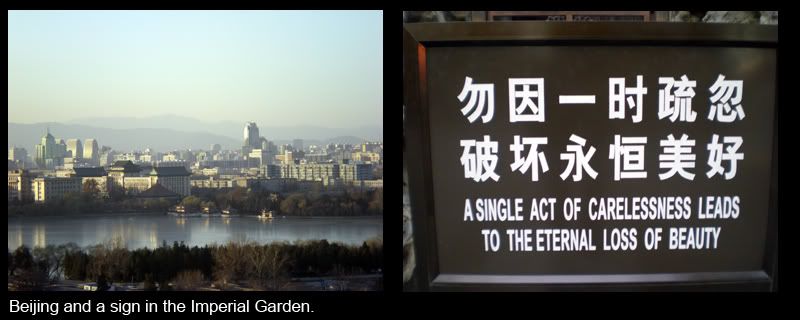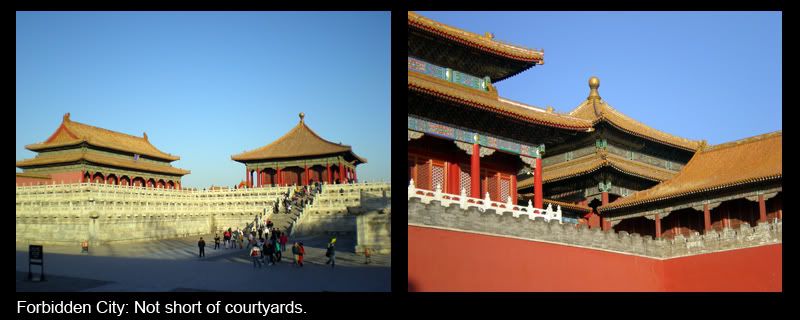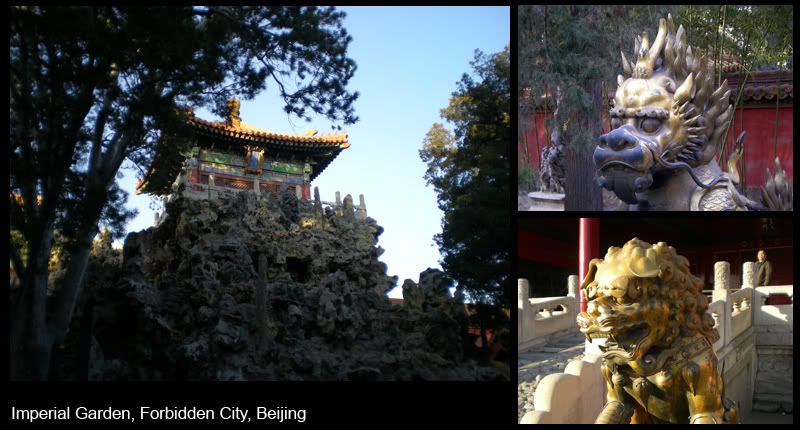Beijing, China
December 6th, 2007
By Dan Murdoch
"A single act of carelessness leads to the eternal loss of beauty."
Sign in The Forbidden City
THE queue was herded from Tiananmen Square across a narrow bridge, flanked on either side by lines of military, each guard demonstratively staring everyone up and down.
Looking for bandits?
I struggled to see what threat could be posed by this sheepish group of sightseers, gawping behind cameras and holding maps upside down.

We passed under the giant portrait of Mao, through thick ochre walls, and into The Forbidden City.
What a title. So named because only the emperor and his court could enter. No commoners allowed please. Well now they queue up en masse to take a look, and not just commoners- but communist commoners, the people excluded by the very title of the place have risen up, overthrown millennia of imperial rule, cast off the feudal yoke, and now form their own chattering parade through the courtyards of power.
At the beginning of the 15th Century the Chinese capital was moved to Beijing, and work on a central complex, the Forbidden City, began in 1406. It took a million workers about 14 years to finish and was home to as many as 9,000 people at a time.
Development continued for the next 500 years while the place hosted 24 emperors, who all provided their own flourishes, whims and fancies. The result is the world’s largest palace complex- more than 800 buildings covering 74 hectares (740,000square metres), palaces, temples, audience chambers, gardens, administrative buildings, shrines, processional avenues and giant courtyards, all enclosed by imposing city walls, overlooked by giant watchtowers and ringed with a deep moat.
In 1947, when the commies got in they toyed with trashing the place- what better symbol of the end of the emperor than to smash the seat of power?
But sense prevailed, and instead they have spent a fair wad keeping the palace renovated and open to the legions of tourists.

I’d arrived alone, but stumbled into Zsofi, OJ and a Swedish girl called Robin at the ticket office. We paid our 40RMB, about $5, only to find the main attraction, The Hall of Supreme Harmony, was being renovated.
This is typical of our trip- of course they’re renovating it now, this is the low point of the low season, no one visits now, everything is cold, and grey and miserable, why would tourists come here now? Anyway the Beijing Olympics begin in nine months, they’ve got to get everything tarted up for the big event.
So what’s the lesson? Don’t travel the world in the off-season. If only we were on schedule…
Despite that disappointment, we were surrounded by grand, stunning buildings. All curved eaves and neatly painted roofs, with shining glazed tiles and marble pillars.
Beautiful, no doubt about it, stunning, historical, steeped in imagery, religion and tradition.
But by the fourth courtyard I got a little restless.
A majestic gateway opening into….another courtyard. It’s a concrete jungle in here, a prophecy of cities to come- giant paved areas, surrounded by buildings.
Maybe the architect ran out of ideas because I got a real sense of déjà vu in each new courtyard. I suspect I am too ignorant to perceive the subtle differences that mark out the various period’s architecture, and too ill-read to grasp the symbolism behind the umpteenth ceremonial gateway.
There are some nice terraces, with some impressive stonework. The Hall of Complete Harmony, nice, the Hall of Preserving Harmony, also nice. But this harmony thing is getting a little thin now.
No wonder the emperor rarely left the city, it’s a right bastard to get out. All those gates and entrances, all those steps, those long courtyards. And the paving is terrible, no good for skateboarding or playing basketball. How’s an emperor to entertain himself?
The last emperor got it right, he had bicycle lanes installed through the complex. Now that’s a thinking emperor.

There are plenty of signs up explaining what the vaguely impressive rooms were used for. My favourite was in the Hall of Preserving Harmony, the Bao He Dia.
As the sign said, Bao He means: “maintaining harmony between all things on earth to have a long period of peace and stability.”
So really it’s the Hall Of Maintaining Harmony Between All Things On Earth To Have A Long Period Of Peace And Stability.
Catchy.
One gateway opened up to show a complex of yellow tinted roofs stretching and sloping elegantly across the eyeline, in the distance a tall hill, thick with green trees is topped by a beautiful looking temple. It is an idyllic setting, a beautiful place. But I found it hard to imagine it in Imperial times, bustling with courtiers not tourists.

At the Hall of Union and Peace the favourite saying of the Emperor Kangxi was written in bold letters on a board hanging at the back.
And the words of wisdom that old Kangxi felt so important they should be memorialised in board form for millions of tourists to glimpse over centuries?
“Doing Nothing.”
These emperors. What a life.
Did I mention The Large Stone Carving?
It’s a large stone carving. The largest in the complex.
These Chinese have a knack for naming things.

At last, at the end of the procession of halls, gateway and courtyards we reached something different. The Imperial Garden, where emperors would relax, entertain and choose girls for their harem.
In spring when the flowers are blooming it must be stunning, but even in dark winter the spidery trees and knotted bows are a majestic playground fit for…well an emperor.
Chinese catalpas, pines, cypresses and wisteria dance across abstract rock formations that hide stairways, towers, chambers and temples.
It was beautiful, one of the most exciting gardens I’ve been to (exciting gardens? Sorry about that). Here I could finally imagine the imperial court: lecherous old emperors with long fading beards making grubby advances on the prettiest youths of Beijing.
Lovely.
IF YOU READ AND ENJOYED THIS BLOG, WHY NOT SHOW YOUR APPRECIATION BY MAKING A SMALL DONATION?
www.firstgiving.com/trabanttrek
100% of your donation goes to Cambodian children’s charities.

Ends
mrdanmurdoch@gmail.com
For more of Dan’s blogs visit: danmurdoch.blogspot.com or www.trabanttrek.org


No comments:
Post a Comment